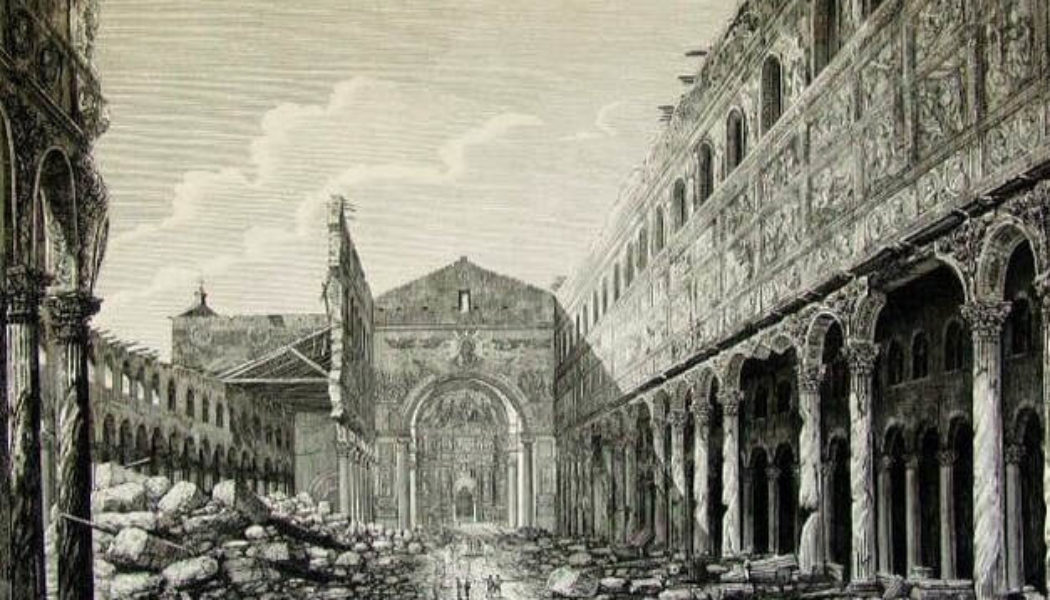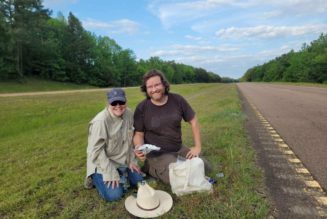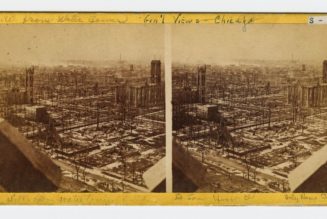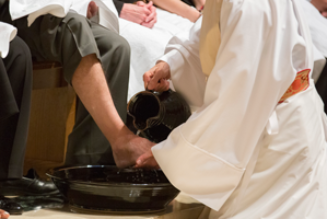
Earlier this week, I was in Rome teaching at the pilot EWTN Summer Academy for young media professionals. At breakfast, one of the participants, looking for an interesting subject to cover for a video project, asked me whether I knew of any major anniversaries in the Church that would have connections to the Eternal City.
I began going back in time by 50-year intervals. 1973, 1923 and 1873 all came up empty in the memory banks.
When I hit 1823, one event popped into mind: the fire that destroyed the Basilica of St. Paul’s Outside the Walls, built over the cella memoriae (tomb) where the former Saul of Tarsus, the “Apostle to the Gentiles,” was buried soon after his decapitation three miles away.
Then I remembered the date of that conflagration: the night of July 15.
And so, with the enthusiastic sense that comes with eureka moments, I replied to the participant: “This Saturday is the 200th anniversary of the burning of St. Paul’s Basilica here in Rome!”
The significance of the date was enough to convince the student and her colleagues that the idea was worth pursuing. It was also enough to get me to use some free time Tuesday afternoon to head to the basilica for a visit, to see how the basilica is marking the bicentenary of its destruction and celebrating the beginning of the extraordinary 31-year worldwide effort to rebuild it.
Since my time as a seminarian in Rome in the ’90s, I have had a special love for the Basilica of St. Paul’s Outside the Walls. During my first year at the Pontifical North American College, almost every Saturday, I used to speed my motorino down to the basilica, where I would sit in a shaded part of the outdoor quadriporticus gazing at its brilliant façade while reading St. Paul’s letters meditatively out loud in Italian. Four conspicuous benefits came from those visits that have never ceased to pay dividends: My prayer life, friendship with St. Paul, knowledge of the New Testament, and Italian skills were all strengthened.
Becoming increasingly familiar and fascinated with St. Paul’s Basilica — called “Outside the Walls” because it’s outside the Aurelian Walls of Rome built in the late third century — I was soon filled with a zeal to bring pilgrims and guests there.
I began to devour all the guidebooks that I could find in gift stores and libraries as I started trying to weave its historical, artistic, architectural, archaeological, scriptural and theological elements together into what I hoped would become a compelling narrative.
The basilica we visit today is the third. The first, built by Constantine in 324 soon after he legalized Christianity, was tiny, basically the area from the altar to the apse today. Starting in 384, the three emperors who made Christianity the official religion of the empire (Theodosius, Valentinian II and Arcadius) united to build for the “Apostle of the Nations” something considerably larger — the basic floor plan of today’s edifice — which was by far the largest church in Rome until the new St. Peter’s was built between 1506 and 1626.
The fire of 1823 was as traumatic to the Christian world as the fire that torched Notre Dame in Paris in April 2019.
The roof of the basilica was leaking during downpours, and Pope Pius VII, a Benedictine who earlier in his life studied and taught at the monastery attached to the basilica and loved it greatly, gave authorization for repairs to be done. On the evening of July 15, two workmen labored late into the night, extending copper gutters on the eaves of the roof toward the façade. After they left, embers that had not been fully extinguished in a pan they were using to heat and mold the copper, escaped to ignite a fire on the roof that would burn until the following morning.
Herdsmen grazing their cows early on July 16 saw the flames and quickly notified the Benedictine monks, two of whom risked their lives to ring the bell to call for help. When, two hours later, the fire brigade arrived with three horse-drawn carriages, carrying two fire pumps, they concluded they would not be able to stop the fire razing the basilica, and so worked, successfully, to save the monastery.
After the fire had burned itself out, it had destroyed the roof, which led to the collapse of the entire north (left) side of the basilica. The triumphal arch with its precious fifth-century mosaics, the altar area built over the apostle’s tomb, the transept and apse with its 13th-century mosaics were spared.
Nine days earlier, Pius VII had fractured his hip. Coupled with his rapidly declining health, he was bedridden, in and out of consciousness. Those around him couldn’t bring themselves to hasten his demise by telling him of the destruction of his beloved Basilica. He died on Aug. 20.
The cardinals elected Annibale della Genga to succeed him, and he took the name Leo XII. He knew that the Jubilee of 1825 was coming, and he hoped to do something to open up for pilgrims the area of the basilica that hadn’t been destroyed. The damage, however, was too extensive. So, instead, he sought to use the jubilee to help the whole world contribute to the rebuilding of the basilica.
On Jan. 25, 1825, the feast of the Conversion of St. Paul during the Jubilee Year, he wrote an encyclical, Ad Plurimas, to the bishops of the world, asking them and the flocks entrusted to them to help in the reconstruction. Saying that he had been inspired by God to make the request, and drawing hope from the contributions from across the world that had helped rebuild St. Peter’s Basilica a few centuries earlier, he said that their collective efforts would be the least they could do to honor the “vessel of election” who brought Christ’s name to the nations and who had suffered poverty, vigils, hunger, shipwrecks, scourging, stoning and martyrdom to confirm the truth of the Gospel to win all for Christ.
“We owe him so much,” he wrote. “Will anyone be so ungrateful not to feel obliged to contribute as much as he can to the glory of the Apostle?” Just as St. Paul used to raise money for the faithful in Jerusalem, he urged them to gather alms for him, confident the Christian people would respond like the widow with her mite in the Gospel so that “the Basilica will rise from the rubble with that magnificence that suits the name and memory of the Doctor of the Gentiles.”
As happened after the fire that severely damaged Notre Dame in Paris in 2019, the people of the world responded with enormous generosity to the desire to rebuild. Catholics dioceses and individuals were, as expected, the most generous contributors, but they weren’t the only ones. Czar Nicholas I of Russia donated priceless malachite and lapus lazuli used for some altars. King Faoud I of Egypt, and his viceroy, Muhammad Ali Pasha, contributed alabaster columns and windows.
The Pope decided that the basilica would be rebuilt, as closely as possible, according to the paleo-Christian fourth-century design, retaining the precious elements saved from the fire, but eliminating most of the Byzantine, Gothic, Renaissance and Baroque embellishments across the centuries.
The reconstruction took three decades and four popes. Finally, on Dec. 10, 1854, two days after solemnly proclaiming the dogma of the Immaculate Conception, Pope Blessed Pius IX led a procession of 50 cardinals and the faithful of Rome from the Vatican to the Ostian Way, where he consecrated the new basilica.
Entering it today, it’s hard not to sense one is entering back into the late fourth century, greeted on the triumphal arch by a mosaic of the Triumphant Christ done under Pope Leo the Great (440-461). Leo started the tradition of depicting the popes in medallion-shaped portraits along the basilica, and what were formerly frescoes are now mosaics of all the popes from St. Peter to Francis.
There are now 36 oil paintings to summarize the dramatic life of St. Paul that run high up throughout the basilica; scenes include St. Paul’s entrance into Rome and his martyrdom. The highlight is always the “confession” before and underneath the high altar, where it is possible, after excavations in 2006, to see part of St. Paul’s sarcophagus.
The history of St. Paul’s Outside the Walls is a chronicle of resilience. It has overcome earthquakes (442 and 1349), plunderings (739 and 847), sacking (1527), a severe flood (1700), and two devastating fires (1115 and 1823). But after each, it was repaired and rebuilt, and is therefore a good image of not only the holy persistence of the holy namesake buried within, but of the Church he helped build and which, in turn, starting 200 years ago, helped rebuild it.









